Global Negative Experiences and Their Impact on Healthcare
-
Aug, Wed, 2024
Global Negative Experiences and Their Impact on Healthcare
The image above, derived from the Gallup Global Emotions 2024 report, provides a striking visualization of the countries with the highest levels of negative experiences worldwide. These experiences, which can include stress, anger, sadness, physical pain, and worry, are particularly concentrated in certain regions, such as parts of Africa, the Middle East, and Asia. The implications of these negative emotions are profound, not only for societal well-being but also for healthcare systems in these countries.
Countries like Guinea, Sierra Leone, and Chad are highlighted with some of the highest scores on the map, reflecting intense levels of negative experiences among their populations. These emotions can have direct and indirect effects on healthcare, as prolonged exposure to stress and negative emotions is linked to a variety of health issues, including cardiovascular diseases, mental health disorders, and a weakened immune system.
For healthcare providers in these regions, the challenge is twofold: treating the immediate physical and psychological symptoms of negative experiences while also addressing the root causes, such as conflict, poverty, and inadequate access to basic needs. In countries like Afghanistan and Iraq, where ongoing conflicts exacerbate the population’s stress and anxiety, healthcare systems are often overwhelmed, under-resourced, and unable to meet the demand for both physical and mental health services.
Moreover, the disparity between the world overall score of 31 and the much higher scores in these highlighted countries (some reaching as high as 53) suggests that global health initiatives must prioritize these regions to reduce the burden of negative experiences. This could involve increased international aid, support for mental health programs, and the development of resilient healthcare infrastructures that can better withstand the pressures of chronic stress and conflict.
Addressing these issues also requires a holistic approach that goes beyond healthcare. Improving education, economic opportunities, and political stability can significantly reduce the prevalence of negative experiences and, in turn, decrease the healthcare burden. For instance, empowering local communities with the tools and resources to manage stress and improve mental health can have a cascading effect, improving overall health outcomes.
In conclusion, the visualization of countries with the most negative experiences underscores the urgent need for targeted healthcare interventions in these regions. By focusing on both the physical and psychological well-being of these populations, and addressing the broader socio-political factors contributing to their distress, we can work towards a healthier, more resilient global community.

